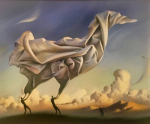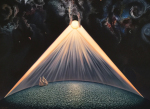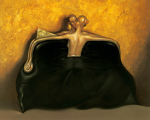Rick Wayne's Blog, page 75
June 29, 2018
The dusky urban fantasy of Guy-Pascal Vallez
The artist’s use of color adds depth and complexity to what is fundamentally simple line work.
[image error] [image error] [image error] [image error] [image error] [image error] [image error] [image error] [image error] [image error] [image error] [image error] [image error] [image error] [image error] [image error] [image error] [image error] [image error]
June 28, 2018
Buried with a donkey, he’s my favorite honkey
From 1978, here is your soundtrack to tonight.
And here is the full ongoing playlist: https://bit.ly/2LUXo2L
The myth of interpretation — and some pretty pictures
The French philosopher and literary critic Roland Barthes developed an extension of Saussure’s semiotics that he called mythology, an apt name since ‘-ology’ technically means ‘study of’ rather than simply ‘collection.’ For Barthes, the semiological system of signifier/signified/sign was itself collectively another signifier that could be parsed, second-order, into a meta-language of myth.
He gives the example of a cover from a French magazine. On it is a photo of an African man in French military uniform. He is giving the French salute, and his stern gaze is lifted toward some object we cannot see — presumably the tricolor, the French flag. At the time (circa 1960), France was politically consumed with the question of empire, and the magazine in question was a bourgeois one — in other words, something like Time or People — such that there was a very particular point, vaguely statist and militaristic, that the empire was vigorous and noble.
I encountered something similar in 2002, at the start of the second Iraq war, when the nation broke out ‘spontaneously’ in ‘patriot rallies.’ People gathered on street corners and waved yellow ribbons at passers by. History records that the war was predicated on a lie, a fact some of us recognized at the time, despite that moderates like General Powell and liberals like Senator Clinton got on TV and told us the opposite. There was a whole deep meaning to these rallies — to the yellow ribbons, to their very publicity. That is, these weren’t ‘patriot parties,’ where people gathered in private celebration. No, they congregated in public spaces and practically threw ribbons at people. And then there’s the name itself, patriot rally, which disguised the truth, that these were in fact pro-war rallies, by subtly suggesting that if you were against the war, you simply weren’t a patriot. Being against the common lie meant being against us.
Interpreting these myths, in Barthes’ phrase, requires deep knowledge of their milieu. If I handed an average American that magazine from 1960 and asked them what, if anything, it was supposed to mean, they might get the opposite result entirely given that in America today 1) we are struggling with issues of race and 2) France is synonymous with runaway liberalism.
For Barthes, myth is entirely bourgeois, which includes not just political conservatives but liberals as well. Only the Left-wing, the radical revolutionaries, he claims, are free from myth since, as the embodiment of revolution, they are constantly remaking them. (Whether that was true in his time, I couldn’t say, but it strikes me as false today. Not that that diminishes his argument. He couldn’t predict the future. But it’s nice to see where these giants are human.)
There are two points. First, although Barthes does not mention it, that system of interpretation, of getting the point of the myth, is genre, which is nothing but a set of conventions for interpreting acts, symbols, and language. Genre is to the signifier of Barthes’ mythology what grammar is to semiotics. Genre is the grammar of myth. In fact, the book on genre I read a couple years ago used an example almost identical to Barthes’s magazine cover: in that case, a newspaper handbill posted repeatedly to a roadside wall in the UK which only made sense if you were familiar with a whole set of cultural and political conventions.
All — or at least almost all — images and discourse have this kind of deep meaning, even (and perhaps especially) the photograph in that a photograph can pretend to be the truth in ways that a painting or novel can’t. This is true even when we are ignorant of the original genre — the system under which the work was created. When we look at a medieval illustration in an illuminated manuscript — or rather, when we see a photograph of the illustration, since very few of us see such things as they are — we are immediately aware of its age. We recognize it as medieval by the style in the same way that every Big Band song sounds like it was from the 1940s. With that recognition comes an entire set of interpretations. Instantly.
The second point is not to complete the analysis but to show that our genres, the multitudinous sets of conventions that we operate under when looking at medieval illustrations or hearing Big Band songs or reading the English translation of a work by the 8th century Chinese poet Li Bai, is entirely different than those held by people for whom those works were created. There is a whole set of meanings that medieval illustration was meant to convey about which we are ignorant — unless of course we’ve had training and education. (But even then, scholars often argue about the right way to look at some historical object or event.)
Indeed, if you study art history — and I wish someone had told me this as a younger man — you aren’t just studying the work in context. You’re studying how both the context and the meaning changed over time. There was a documentary series on the BBC a number of years back called “The Private Life of a Masterpiece” where each episode looked not only at the conditions of a particular work of art today and at its origin but also at how that evolved between. People reacted a certain way to a Vermeer when he was painting in the 17th century. (He died when he was my age.) That reaction changed in the Victorian era, as well as before and after.
Today, when we see a Vermeer, we mostly see money — an interpretation facilitated by the genre of ‘the masterpiece,’ which says among other things that for something to be a masterpiece, for us to experience it as such, it needs to be framed ornately and hanging by itself on a drab white wall inside a tomb-like museum with guards and heavy gates, exactly as one might find inside a bank vault. A Vermeer is dead. It is entombed. It has ceased to be about what it represents, except as a kind of afterthought. People don’t generally gather to gasp at scenes from 17th century middle class Dutch life. They might, if they are very aware, marvel at the construction of the painting, the brush strokes and the like. But mostly what we’re gasping at is how such a little thing could be worth so much god-damned money.
Of course, there’s also the genre of ‘the masterpiece out of water,’ embodied in books about art theft, crime novels, and Antiques Roadshow. If we keep going, there’s also my description of that genre: ‘the masterpiece out of water.’ That simple phrase can be decrypted in the same way we decrypt myth. It also has a genre. It requires a common convention for you to parse the meaning, which isn’t that every lost masterpiece was once submerged, like the Riace bronzes, or that we baptize them like infants when they’re recovered. That shared convention that allows you to interpret the meaning is different than that meaning, and we analyze it, not to be pedantic, but because common conventions — genres — constrain our view of the world without us even realizing.
This activity is the exact opposite of pedantry. The pedant ignores myth. She pretends not to understand the real meaning of your utterance in order that she may correct your grammar, to enforce a rule, whereby she’s enforcing her power as a grammarian. So it is with politicians, like Senator Clinton or the President, who are the pedants of genre (which we have seen is the grammar of myth). Their art is convincing others that there is nothing to be seen, or that meanings are different than intended, in order to assert power.
Now, parse the image below.
[image error]
What is the intended meaning? How does that differ from what it actually represents? Is it ironic or not? How would it be different if this were an illustration rather than a photograph? When AI can generate completely realistic yet fake images with whimsy, will people be more critical? Will you? Will you stop sharing funny pictures simply because they might be fake? Or will you share them as if they were true, thereby not just participating but actually proselytizing myth?
Now, repeat the exercise with this art by David Altmejd:
[image error]
Or this photo of cats lined up for an audition in Hollywood:
[image error]
Or this image of the Hulk by Luke Ross:
[image error]
Or this photo of the Palace of Weddings, Bishkek, Kyrgyzstan
[image error]
Or this Japanese bamboo basket:
[image error]
Now, look back at the cover image.
June 26, 2018
T. Rex – Mambo Sun
Here is your soundtrack to tonight.
And here is the full ongoing playlist:
The heavy metal horrors of Florian Bertmer
[image error] [image error] [image error] [image error] [image error] [image error] [image error]
June 25, 2018
The ridiculousness of everything
It’s true that much of the world is ridiculous. I think most people would agree with that. However, in their agreement they would be wrong. This is because at the moment of utterance, the cynical speaker, in claiming the world is ridiculous, assumes the role of Barthes’ dumb critic who believes herself “to have such sureness of intelligence that acknowledging an inability to understand calls in question the clarity of the author and not of [her] own mind.”
That is, if the world is ridiculous, or in other ways abstruse, then the cynic can be forgiven their inability to make sense of it because there’s nothing to make sense of. The very ridiculousness of things is proof that she has as good a handle on them as can be got.
Paradoxically, this is the very source of ridiculousness. Absence of understanding becomes the naturalized justification for the pantomime of most daily acts, where that pantomime is itself offered as evidence of the ridiculousness on which the lack of understanding depends. And since ridiculousness, being irrational, evades the order of cause and effect, the pantomime of daily life appears to the cynic as if it were the natural order of things — perhaps even the necessary order of things — when in fact the reverse is true. The ridiculousness of the world is manufactured by and contingent upon all our silly pantomimes.
I’ll give an example. The intellectual is the only person who can assume the role of Barthes’ dumb critic, which means the idiot actually stands closer to the truth than the educated man. In as much as the unlearned assumes his lack of understanding comes not from a surfeit of intelligence but from a dearth of it, he sees the ridiculousness of the world as evidence of malice against him, however impersonal — which is to say, a result his inferiority vis a vis the world, a stance several steps closer to the truth.
cover image by Mateo Pizarro
June 24, 2018
The metaphorical realism of Vladimir Kush
Vladimir Kush (b. 1968) is a Russian painter who emigrated to Hawaii in 1990 and since opened galleries there and in Las Vegas and Laguna Beach. Working primarily in oil, his paintings are surrealist, investigating the symbolic relation between man and nature.














June 23, 2018
The Thinker of Cernavoda
This four-and-a-half-inch-tall terracotta sculpture was a product of the late stone-age “Hamangia culture” of present-day Romania and dates to approximately 5,000 BCE. Most of the extant art of the era depicts hunting or fertility, but the “thinker” (Ganditorul) is clearly sitting in introspection in an almost identical pose to the famous statue by Rodin, despite the gap of 7,000 years. (Note that the older thinker wasn’t discovered until 1956, while the younger was conceived in 1880.)
The thinker of Cernavoda is, without a doubt, my favorite work of art in the entire history of our species. It is staggeringly ancient. It pre-dates the Bible (both Old and New Testaments), the great pyramids, even writing itself, which didn’t appear in Mesopotamia for another 1,500 years. And yet, looking at it, we can immediately identify with this pensive fellow and share in his thoughts and struggles which suggests to me that — whatever else has happened — being human hasn’t changed all that much.
[image error]
June 22, 2018
Snail Mail – Pristine
June 21, 2018
The high-literary surrealism of Dino Buzzati
It seems to me, fantasy should be as close as possible to journalism. The right word is not “banalizing”, although in fact a little of this is involved. Rather, I mean that the effectiveness of a fantastic story will depend on its being told in the most simple and practical terms.
Dino Buzzati (1906-1972) was an Italian novelist, composer, playwright, poet, children’s author, illustrator, and surrealist artist. The privileged son of a veterinarian and professor of law, Buzzati studied law himself before finding work as a journalist, where he worked the rest of his life.
Buzzati covered WWII in Africa, attached to the Royal Navy. In the lead-up to the conflict, he wrote his most famous work, Il deserto dei tartare (The Tartar Steppe, 1940), which Le Monde ranked 29th on its list of the 100 books of the century. The story follows military officer Giovanni Drogo, who spends his life spent guarding the Bastiani Fortress, an old, unmaintained border outpost, in anticipation of an attack that never seems to come. “Without noticing, Drogo finds that in his watch over the fort he has let years and decades pass and that, while his old friends in the city have had children, married, and lived full lives, he has come away with nothing except solidarity with his fellow soldiers in their long, patient vigil. When the attack by the Tartars finally arrives, Drogo gets ill and the new chieftain of the fortress dismisses him. Drogo, on his way back home, dies lonely in an inn.” (Wikipedia)
Across his life, Buzzati was also an artist, chiefly of symbolist/surrealist images, and an illustrator of his own stories. In 1945, based on his experiences in the war, he published a children’s book, La famosa invasione degli orsi in Sicilia (translated as The Bears’ Famous Invasion of Sicily), in which a group of bears descend from their mountain home after a particular brutal winter. Desperate and with nothing to eat, the bears assault the capital. Although first beaten back by human technology, the bears learn to make ladders and catapults and are eventually successful. After adopting human vices, including gambling, deceit, theft, and an attempted coup, the King of Sicily orders the bears to return to their mountain home.
Although he is highly regarded in Europe, France in particular, Buzzati is almost unknown in English. His work tends toward magical realism, more in vogue now than in his own time, and his major themes — social alienation, environmental decay, and the fantastical elements of new technology — remain vigorous. His short story collections, one of which won the Stega Prize in 1958, often feature fantastic creatures, including one he invented himself, colomber, as well as elements of science fiction, fantasy, and horror.
In 1969, Buzzati released Poema a fumetti (Comic Poem), a modern retelling of the myth of Orpheus and Eurydice in words and pictures, a kind of proto-graphic novel. The first English translation wasn’t released until 2009. I am reading it now, and although it seems to have lost some of the lyricism of the original Italian, the images, some of which are reproduced below, are striking and expertly paired with the text. Sadly, I can’t find where Buzzati’s work has influenced many people in the English-speaking world, although Lemony Snicket did write the introduction and reader’s guide to The Bears’ Famous Invasion of Sicily.
[image error] [image error] [image error] [image error] [image error] [image error] [image error] [image error] [image error] [image error] [image error] [image error] [image error] [image error] [image error] [image error]



